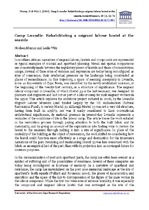Camp Lwandle: Rehabilitating a migrant labour hostel at the seaside
Abstract
In southern African narratives of migrant labour, hostels and compounds are
represented as typical examples of colonial and apartheid planning. Visual and
spatial comparisons are consistently made between the regulatory power of hostels
and those of concentration camps. Several of these sites of violence and
repression are today being reconfigured as sites of conscience, their artefactual
presence on the landscape being constructed as places of remembrance. In this
trajectory, a space of seeming anonymity in Lwandle, some 40 km outside of
Cape Town, was identified by the newly established museum, at the beginning
of the twenty-first century, as a structure of significance. The migrant labour
compound in Lwandle, of which Hostel 33 is the last remnant, was designed by
planners and engineers and laid out as part of a labour camp for male migrant
workers in the 1950s. This article explores the ambitious project initiated in
2008, by the Lwandle Migrant Labour Museum (and funded largely by the US
Ambassadors Cultural Restoration Fund), to restore Hostel 33. Although Hostel
33 was not a very old structure, having been built in 1958/9, nor was it easily
considered to have conventional architectural significance, its material presence
in present-day Lwandle represents a reminder of the conditions of life in the
labour camp. The article traces the work entailed in the restoration process
through paying attention to both the built fabric and its materiality, and by giving
an account of the explorations into finding ways to restore the hostel to the
museum through making it into a site of significance. In place of the centrality
of the building as the object of restoration, the work shifted to considering how
the hostel could function most effectively as a stage and destination for the
Museum’s narrations of the past. Retaining and maintaining Hostel 33 was less
concerned with the fabric as an empirical fact of the past, than with its projection
into an envisaged future for museum purposes.

